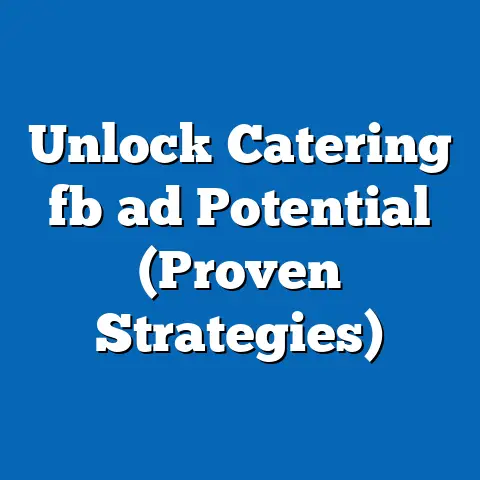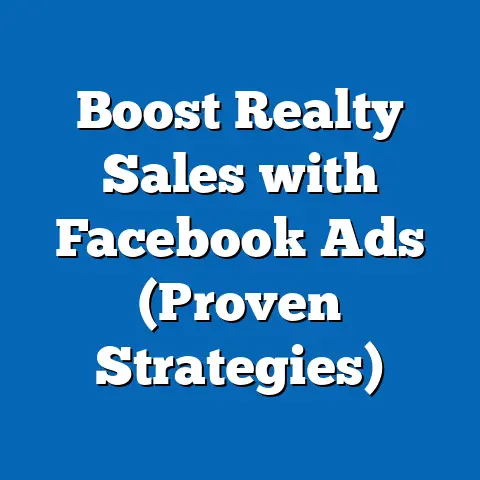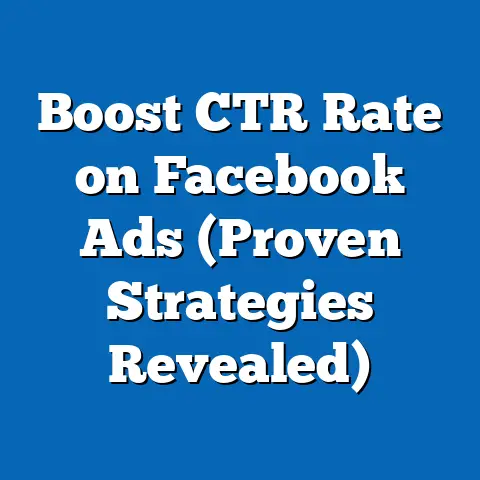Boost Sales with Celery Facebook Ads (Expert Strategies)
Facebook advertising has become an indispensable tool for businesses of all sizes, but particularly for small to medium-sized enterprises (SMBs). Did you know that Facebook ads can increase brand awareness by as much as 80%? Moreover, businesses report an average return of $5.24 for every $1 spent on Facebook ads. As someone who’s navigated the complex landscape of Facebook marketing for years, I’ve seen firsthand how a well-crafted campaign can dramatically transform a business’s fortunes. In this guide, I’m going to share my expert strategies for leveraging Facebook ads to boost sales, focusing on a unique product or service called Celery.
Celery, in this context, is a hypothetical business offering a curated selection of home goods designed to enhance different living spaces. Think of it as a brand that sells everything from cozy blankets for your living room to ergonomic desk organizers for your home office. The key to Celery’s success lies in understanding that each space – each “room” – has distinct needs and preferences. That’s where Facebook advertising comes in.
The power of Facebook advertising isn’t just about reaching a broad audience; it’s about reaching the right audience with the right message. This requires a deep understanding of your customer base and tailoring your ads to resonate with their specific needs and desires. In this article, I’ll show you how to harness the full potential of Facebook Ads to boost sales for Celery by focusing on “room-specific needs.” By the end, you’ll have a clear roadmap for crafting targeted, effective campaigns that drive conversions and maximize your ROI.
Section 1: Understanding Room-Specific Needs
1.1 Defining Room-Specific Needs
What exactly do I mean by “room-specific needs?” It’s a concept that emphasizes segmenting your audience based on the different living spaces they’re trying to improve or equip. Think about it: someone shopping for their kitchen has vastly different requirements than someone furnishing their living room. The key is to identify these distinct needs and tailor your advertising accordingly.
For example, a person furnishing a home office might be interested in products that promote productivity and comfort, such as ergonomic chairs, noise-canceling headphones, or stylish desk organizers. On the other hand, someone looking to enhance their living room might be more interested in items that promote relaxation and entertainment, like plush sofas, smart TVs, or ambient lighting.
By recognizing these differences, you can create highly targeted Facebook ad campaigns that speak directly to the needs and desires of each segment. This approach leads to higher engagement rates, improved click-through rates (CTR), and ultimately, increased sales. In my experience, ads that directly address a specific need or pain point are far more effective than generic ones.
1.2 Identifying Your Audience
Identifying the unique needs of each room segment requires a combination of research, analysis, and a deep understanding of your target audience. Here are some strategies I’ve found particularly effective:
- Surveys: Conduct online surveys to gather direct feedback from potential customers. Ask questions about their current living spaces, their biggest challenges, and the types of products they’re interested in. Tools like SurveyMonkey or Google Forms can make this process easy and affordable.
- Focus Groups: Organize small focus groups to gain qualitative insights into customer preferences and needs. This allows for more in-depth discussions and a deeper understanding of the motivations behind purchasing decisions. I once ran a focus group for a client selling kitchen gadgets, and we discovered that customers were more concerned with ease of cleaning than with advanced features. This insight completely changed our ad messaging.
- Analytics: Analyze your website and social media analytics to identify patterns in customer behavior. Pay attention to which products are most popular in each category, which keywords are driving traffic to your site, and which demographics are most engaged with your content. Google Analytics and Facebook Insights are invaluable tools for this purpose.
- Customer Personas: Develop detailed customer personas for each room segment. These personas should include information about their age, gender, income, lifestyle, and pain points. This helps you visualize your target audience and tailor your messaging accordingly.
- Social Listening: Monitor social media conversations to identify trends and insights related to home decor and improvement. Use tools like Mention or Brandwatch to track keywords and hashtags related to your niche.
Remember, the more you know about your audience, the better equipped you’ll be to craft effective Facebook ads that resonate with their specific needs and desires.
1.3 Tailoring Your Message
Once you’ve identified the unique needs of each room segment, the next step is to tailor your messaging accordingly. This means crafting ad copy and visuals that speak directly to the pain points and desires of your target audience.
For example, if you’re targeting the “home office” segment, your ad copy might focus on the benefits of increased productivity and comfort. You could highlight features like ergonomic design, noise-canceling technology, or stylish aesthetics. Your visuals might showcase a well-organized and inviting home office setup.
On the other hand, if you’re targeting the “living room” segment, your ad copy might emphasize relaxation, entertainment, and social connection. You could highlight features like plush cushions, immersive sound systems, or stylish designs that enhance the overall ambiance of the room. Your visuals might showcase a cozy and inviting living room scene, perfect for relaxing with family or entertaining friends.
Here are a few examples of how businesses have successfully modified their ad copy and visuals to resonate with different audience segments:
- Example 1: A furniture retailer ran two different Facebook ads for the same sofa. One ad targeted young professionals and emphasized the sofa’s sleek design and space-saving features. The other ad targeted families and highlighted the sofa’s durability and stain-resistant fabric.
- Example 2: A lighting company created separate ads for bedroom lighting and kitchen lighting. The bedroom lighting ad featured warm, soft lighting and focused on creating a relaxing atmosphere. The kitchen lighting ad featured bright, energy-efficient lighting and emphasized functionality.
- Example 3: A home organization company ran different ads for closet organizers and pantry organizers. The closet organizer ad highlighted the benefits of increased storage space and improved organization. The pantry organizer ad emphasized the benefits of reducing food waste and creating a more efficient cooking space.
In each of these examples, the businesses tailored their messaging to resonate with the specific needs and desires of their target audience. This resulted in higher engagement rates, improved click-through rates, and ultimately, increased sales.
Takeaway: Understanding room-specific needs is crucial for crafting effective Facebook ads. By identifying your audience, tailoring your message, and using relevant visuals, you can create campaigns that resonate with your target audience and drive conversions.
Section 2: Crafting Effective Facebook Ads for Celery
2.1 The Anatomy of a Winning Facebook Ad
A winning Facebook ad is more than just a pretty picture and catchy slogan. It’s a carefully crafted combination of several key components, all working together to achieve a specific goal. Let’s break down the anatomy of a successful Facebook ad:
- Visuals: The visual is often the first thing people see, so it needs to be eye-catching and relevant. Use high-quality images or videos that showcase your product or service in the best possible light.
- Headline: The headline is your opportunity to grab attention and pique interest. Keep it short, concise, and compelling.
- Body Copy: The body copy should expand on the headline and provide more information about your product or service. Focus on the benefits, not just the features.
- Call-to-Action (CTA): The CTA tells people what you want them to do next. Use clear and concise language, such as “Shop Now,” “Learn More,” or “Sign Up.”
- Targeting: Targeting allows you to reach the right people with your ads. Use Facebook’s advanced targeting options to narrow your audience based on demographics, interests, behaviors, and more.
Now, let’s see how we can align these components with the identified room-specific needs for Celery:
- Living Room Ad:
- Visual: A cozy living room scene with Celery’s plush blankets, stylish throw pillows, and ambient lighting.
- Headline: “Transform Your Living Room into a Relaxation Oasis.”
- Body Copy: “Create the perfect space for relaxation and entertainment with Celery’s curated collection of home goods. From plush blankets to stylish throw pillows, we have everything you need to transform your living room into a cozy oasis.”
- CTA: “Shop Now”
- Home Office Ad:
- Visual: A well-organized and inviting home office setup with Celery’s ergonomic chair, desk organizer, and noise-canceling headphones.
- Headline: “Boost Your Productivity with a Stylish Home Office.”
- Body Copy: “Create a productive and comfortable workspace with Celery’s curated collection of home office essentials. From ergonomic chairs to stylish desk organizers, we have everything you need to boost your productivity and stay focused.”
- CTA: “Learn More”
- Kitchen Ad:
- Visual: A bright and functional kitchen with Celery’s smart storage solutions, efficient gadgets, and stylish accessories.
- Headline: “Make Cooking a Breeze with Celery’s Kitchen Essentials.”
- Body Copy: “Transform your kitchen into a culinary haven with Celery’s curated collection of kitchen essentials. From smart storage solutions to efficient gadgets, we have everything you need to make cooking a breeze.”
- CTA: “Shop Now”
- Visual: A cozy living room scene with Celery’s plush blankets, stylish throw pillows, and ambient lighting.
- Headline: “Transform Your Living Room into a Relaxation Oasis.”
- Body Copy: “Create the perfect space for relaxation and entertainment with Celery’s curated collection of home goods. From plush blankets to stylish throw pillows, we have everything you need to transform your living room into a cozy oasis.”
- CTA: “Shop Now”
- Visual: A well-organized and inviting home office setup with Celery’s ergonomic chair, desk organizer, and noise-canceling headphones.
- Headline: “Boost Your Productivity with a Stylish Home Office.”
- Body Copy: “Create a productive and comfortable workspace with Celery’s curated collection of home office essentials. From ergonomic chairs to stylish desk organizers, we have everything you need to boost your productivity and stay focused.”
- CTA: “Learn More”
- Visual: A bright and functional kitchen with Celery’s smart storage solutions, efficient gadgets, and stylish accessories.
- Headline: “Make Cooking a Breeze with Celery’s Kitchen Essentials.”
- Body Copy: “Transform your kitchen into a culinary haven with Celery’s curated collection of kitchen essentials. From smart storage solutions to efficient gadgets, we have everything you need to make cooking a breeze.”
- CTA: “Shop Now”
By aligning these components with the specific needs of each room segment, you can create Facebook ads that resonate with your target audience and drive conversions.
2.2 Leveraging Visuals
In Facebook advertising, visuals are king. People are naturally drawn to images and videos, so it’s crucial to use high-quality visuals that capture attention and convey your message effectively. For a product like Celery, which sells home goods designed to enhance different living spaces, visuals are particularly important.
Here are some tips for leveraging visuals in your Facebook ads:
- Use high-quality images and videos: Avoid using blurry or pixelated visuals. Invest in professional photography or videography to showcase your products in the best possible light.
- Showcase your products in context: Instead of just showing a product on a white background, show it in a real-life setting. This helps people visualize how the product would look in their own home.
- Evoke emotions: Use visuals that evoke the desired emotions for each room segment. For the living room segment, use visuals that evoke feelings of relaxation, comfort, and warmth. For the home office segment, use visuals that evoke feelings of productivity, focus, and organization.
- Use video to tell a story: Video is a powerful tool for capturing attention and conveying your message. Create short videos that showcase the benefits of your products and tell a compelling story.
- Test different visuals: A/B test different visuals to see which ones perform best. Try different images, videos, and even different angles and compositions.
For example, if Celery is advertising a set of luxurious bedsheets, the visual could be a close-up of the soft fabric, or a wide shot of a beautifully made bed in a serene bedroom. The key is to make the visual appealing and relevant to the target audience.
2.3 Writing Compelling Copy
While visuals are important, the ad copy is what ultimately convinces people to take action. Your ad copy should be clear, concise, and compelling, and it should speak directly to the pain points and desires of your target audience.
Here are some tips for writing compelling ad copy:
- Focus on the benefits, not the features: People don’t care about the features of your product; they care about the benefits. Explain how your product will solve their problems or improve their lives.
- Use strong verbs and adjectives: Use language that is active and engaging. Avoid using weak or passive verbs.
- Keep it short and sweet: People have short attention spans, so keep your ad copy concise and to the point.
- Use a clear call-to-action: Tell people exactly what you want them to do next. Use clear and concise language, such as “Shop Now,” “Learn More,” or “Sign Up.”
- Address pain points: Identify the specific pain points of your target audience and explain how your product can solve them.
- Use social proof: Include testimonials or reviews from satisfied customers to build trust and credibility.
- Test different ad copy: A/B test different ad copy variations to see which ones perform best. Try different headlines, body copy, and calls to action.
Here are a few examples of successful ad copy from similar niches:
- “Transform your bedroom into a sanctuary with our luxurious bedsheets. Made from the finest Egyptian cotton, our bedsheets are incredibly soft, breathable, and durable. Shop now and experience the ultimate in comfort.”
- “Boost your productivity with our ergonomic office chair. Designed to provide optimal support and comfort, our chair will help you stay focused and energized throughout the day. Learn more and get 10% off your first order.”
- “Organize your kitchen with our smart storage solutions. Our containers are airtight, leak-proof, and BPA-free, so you can keep your food fresh and organized. Shop now and get free shipping on orders over $50.”
Remember, the key to writing compelling ad copy is to understand your target audience and speak directly to their needs and desires.
Takeaway: Crafting effective Facebook ads for Celery involves understanding the anatomy of a winning ad, leveraging visuals effectively, and writing compelling copy. By aligning these components with the identified room-specific needs, you can create Facebook ads that resonate with your target audience and drive conversions.
Section 3: Targeting and Retargeting Strategies
3.1 Facebook’s Targeting Options
Facebook’s targeting options are incredibly powerful, allowing you to reach specific demographics, interests, and behaviors. This is crucial for Celery, as you want to ensure your ads are seen by people who are actually interested in home goods and decor.
Here’s a breakdown of some key targeting options:
- Demographics: Target users based on age, gender, location, education, relationship status, and more. For Celery, you might target homeowners aged 25-55 who live in urban areas.
- Interests: Target users based on their interests, hobbies, and passions. For Celery, you might target users interested in home decor, interior design, DIY projects, and specific brands like IKEA or West Elm.
- Behaviors: Target users based on their online behavior, such as purchase history, device usage, and travel habits. For Celery, you might target users who have recently purchased furniture or home goods online.
- Custom Audiences: Create custom audiences based on your existing customer data, such as email lists or website visitors. This allows you to target people who are already familiar with your brand.
- Lookalike Audiences: Create lookalike audiences based on your custom audiences. This allows you to reach new people who are similar to your existing customers.
For Celery, consider creating separate ad sets for each room segment, using the targeting options to reach the most relevant audience. For example, the “home office” ad set might target users interested in productivity, organization, and technology, while the “living room” ad set might target users interested in home decor, entertainment, and relaxation.
3.2 Creating Custom Audiences
Custom audiences are one of the most powerful targeting tools available on Facebook. They allow you to target people who have already interacted with your business, such as website visitors, email subscribers, or customers.
Here are a few ways you can create custom audiences for Celery:
- Website Visitors: Create a custom audience of people who have visited your website. You can further segment this audience based on the specific pages they visited. For example, you could create a custom audience of people who visited the “living room” section of your website.
- Email List: Upload your email list to Facebook to create a custom audience of your subscribers. This allows you to target people who have already expressed interest in your brand.
- Customer List: Upload your customer list to Facebook to create a custom audience of your existing customers. This allows you to target your most loyal customers with special offers or promotions.
- Facebook Page Engagement: Create a custom audience of people who have engaged with your Facebook page, such as liking your page, commenting on your posts, or watching your videos.
- Instagram Profile Engagement: Similar to Facebook Page Engagement, you can create custom audiences of users engaging with your Instagram profile.
Custom audiences are particularly effective for retargeting, which we’ll discuss in more detail later.
3.3 Utilizing Lookalike Audiences
Once you’ve created custom audiences, you can use them to create lookalike audiences. Lookalike audiences are a powerful way to expand your reach and find new potential buyers who are similar to your existing customers.
Facebook uses its algorithm to analyze the characteristics of your custom audience and identify other users who share similar traits. This allows you to reach a much larger audience than you could with just your custom audience alone.
Here are a few tips for creating effective lookalike audiences:
- Start with your best custom audience: Use your most valuable custom audience as the source for your lookalike audience. This could be your customer list, your email list, or your website visitors.
- Choose the right audience size: Facebook allows you to choose the size of your lookalike audience, ranging from 1% to 10% of the population in your target country. A smaller audience will be more similar to your source audience, while a larger audience will be less similar but will have a wider reach. I usually start with a 1% lookalike audience and gradually increase the size as needed.
- Test different lookalike audiences: Create multiple lookalike audiences based on different custom audiences and test them against each other to see which ones perform best.
For Celery, you could create lookalike audiences based on your customer list, your email list, and your website visitors. You could then test these lookalike audiences against each other to see which ones drive the most sales.
3.4 Retargeting Strategies
Retargeting is a powerful advertising technique that allows you to re-engage users who have previously interacted with your business but haven’t yet converted. This is particularly effective for Celery, as many people might browse your website or view your products but not make a purchase right away.
Here are some effective retargeting strategies for Celery ads:
- Website Retargeting: Show ads to people who have visited your website but haven’t made a purchase. You can further segment this audience based on the specific pages they visited. For example, you could show ads for living room furniture to people who visited the “living room” section of your website.
- Dynamic Product Ads: Use dynamic product ads to show people ads for the specific products they viewed on your website. This is a highly effective way to remind people of the products they were interested in and encourage them to make a purchase.
- Abandoned Cart Retargeting: Show ads to people who added products to their cart but didn’t complete the checkout process. Offer them a discount or free shipping to encourage them to complete their purchase.
- Video Retargeting: Show ads to people who have watched your videos on Facebook or Instagram. This is a great way to re-engage people who have shown interest in your brand and encourage them to learn more.
- Email Retargeting: Upload your email list to Facebook and show ads to your subscribers who haven’t made a purchase. This is a great way to remind them of your brand and encourage them to visit your website.
Takeaway: Targeting and retargeting are crucial for maximizing the effectiveness of your Facebook ads. By using Facebook’s advanced targeting options, creating custom audiences, utilizing lookalike audiences, and implementing effective retargeting strategies, you can reach the right people with the right message and drive conversions.
Section 4: Budgeting and Bidding Strategies
4.1 Setting a Budget for Your Campaign
Setting a budget for your Facebook ad campaign can feel like a shot in the dark, but it doesn’t have to be. The key is to align your budget with your business goals and expected ROI.
Here are some guidelines for setting a realistic budget:
- Define your goals: What are you trying to achieve with your Facebook ads? Are you trying to increase brand awareness, generate leads, or drive sales? Your budget should be aligned with your goals.
- Calculate your customer lifetime value (CLTV): How much revenue does each customer generate for your business over their lifetime? This will help you determine how much you can afford to spend on acquiring a new customer.
- Estimate your conversion rate: What percentage of people who click on your ads will actually make a purchase? This will help you determine how many clicks you need to generate to achieve your goals.
- Consider your competition: How much are your competitors spending on Facebook ads? This will give you a sense of the average cost per click (CPC) in your industry.
- Start small and scale up: It’s always better to start with a smaller budget and gradually increase it as you see results. This allows you to test different ad variations and targeting options without risking too much money.
As a rule of thumb, I recommend starting with a daily budget of $5-$10 per ad set. This will give you enough data to see which ads are performing well and which ones aren’t. Once you’ve identified your best-performing ads, you can gradually increase your budget to reach a larger audience.
4.2 Understanding Bidding Strategies
Facebook offers several different bidding strategies, each with its own advantages and disadvantages. Choosing the right bidding strategy is crucial for maximizing the effectiveness of your ad campaign.
Here are some of the most common bidding strategies:
- Lowest Cost: This is the default bidding strategy, and it aims to get you the most results for your budget. Facebook will automatically bid on the lowest-cost opportunities, but it may not always deliver the best quality results.
- Cost Cap: This bidding strategy allows you to set a maximum cost per result. Facebook will try to get you results at or below your cost cap, but it may not always spend your entire budget.
- Target Cost: This bidding strategy allows you to set a target cost per result. Facebook will try to get you results as close to your target cost as possible, but it may not always spend your entire budget.
- Bid Cap: This bidding strategy allows you to set a maximum bid for each auction. Facebook will never bid more than your bid cap, but it may not always win the auction.
- Manual Bidding: This bidding strategy gives you complete control over your bids. You can manually set your bids for each auction, but it requires a lot of time and effort.
For Celery, I recommend starting with the “Lowest Cost” bidding strategy. This will allow you to get a sense of the average cost per result in your industry. Once you have enough data, you can experiment with other bidding strategies to see which one performs best.
4.3 Allocating Budget by Room Segment
Once you’ve set your overall budget and chosen your bidding strategy, the next step is to allocate your budget across different room segments. This is where your understanding of room-specific needs comes into play.
Here are some factors to consider when allocating your budget:
- Audience Size: The larger the audience, the more budget you’ll need to reach them effectively.
- Potential ROI: Which room segments have the highest potential ROI? Allocate more budget to these segments.
- Competition: How competitive is each room segment? Allocate more budget to segments with less competition.
- Seasonality: Are there certain times of the year when demand for certain products is higher? Allocate more budget to these products during those times.
For example, if Celery is launching a new line of home office furniture, you might allocate more budget to the “home office” segment during the launch period. Or, if you know that demand for outdoor furniture is higher in the summer, you might allocate more budget to the “outdoor living” segment during the summer months.
Here’s an example of how you might allocate a $100 daily budget across different room segments:
- Living Room: $40
- Home Office: $30
- Kitchen: $20
- Bedroom: $10
This allocation is based on the assumption that the living room and home office segments have the largest audience size and the highest potential ROI.
Takeaway: Budgeting and bidding strategies are crucial for maximizing the effectiveness of your Facebook ads. By setting a realistic budget, understanding different bidding strategies, and allocating your budget effectively across different room segments, you can drive conversions and achieve your business goals.
Section 5: Analyzing Performance and Optimizing Campaigns
5.1 Key Performance Metrics
Analyzing the performance of your Facebook ad campaigns is crucial for understanding what’s working and what’s not. By tracking key performance indicators (KPIs), you can identify areas for improvement and optimize your campaigns for better results.
Here are some of the most important KPIs to track for Celery ad campaigns:
- Click-Through Rate (CTR): This is the percentage of people who click on your ad after seeing it. A high CTR indicates that your ad is relevant and engaging to your target audience.
- Conversion Rate: This is the percentage of people who take the desired action after clicking on your ad, such as making a purchase or signing up for a newsletter. A high conversion rate indicates that your ad is effective at driving conversions.
- Cost Per Click (CPC): This is the average cost you pay each time someone clicks on your ad. A low CPC indicates that your ad is efficient at driving traffic to your website.
- Cost Per Acquisition (CPA): This is the average cost you pay each time someone takes the desired action, such as making a purchase or signing up for a newsletter. A low CPA indicates that your ad is efficient at driving conversions.
- Return on Ad Spend (ROAS): This is the amount of revenue you generate for every dollar you spend on advertising. A high ROAS indicates that your ad is profitable.
- Frequency: This is the average number of times each person sees your ad. A high frequency can lead to ad fatigue, so it’s important to monitor this metric and adjust your targeting or creative as needed.
You can track these KPIs in the Facebook Ads Manager. I recommend setting up custom reports to track the metrics that are most important to your business.
5.2 A/B Testing
A/B testing is the process of testing different variations of your ads to see which one performs best. This is a crucial step in optimizing your campaigns for better results.
Here are some elements you can A/B test in your Facebook ads:
- Headline: Test different headlines to see which one grabs the most attention.
- Body Copy: Test different body copy variations to see which one resonates best with your target audience.
- Visuals: Test different images and videos to see which ones are most engaging.
- Call-to-Action: Test different calls to action to see which one drives the most conversions.
- Targeting: Test different targeting options to see which one reaches the most relevant audience.
- Placement: Test different ad placements to see which one performs best.
When A/B testing, it’s important to only test one element at a time. This will allow you to accurately measure the impact of each change.
For example, you could A/B test two different headlines for your living room furniture ad. One headline might focus on the comfort of the furniture, while the other might focus on the style. By tracking the CTR and conversion rate of each ad, you can determine which headline is more effective.
5.3 Making Data-Driven Decisions
The ultimate goal of analyzing performance and A/B testing is to make data-driven decisions that improve your campaign results. This means using the data you collect to identify areas for improvement and make informed decisions about your targeting, creative, and bidding strategies.
Here are some examples of how you can use data to optimize your Facebook ad campaigns:
- If your CTR is low: Try testing different headlines, body copy, or visuals to see if you can improve engagement.
- If your conversion rate is low: Make sure your landing page is optimized for conversions. Test different landing page layouts, calls to action, and product descriptions.
- If your CPC is high: Try narrowing your targeting or using a different bidding strategy.
- If your CPA is high: Try improving your conversion rate or lowering your CPC.
- If your ROAS is low: Try improving your conversion rate, lowering your CPA, or increasing your average order value.
By continuously analyzing your performance and making data-driven decisions, you can optimize your Facebook ad campaigns for maximum ROI.
Takeaway: Analyzing performance and optimizing campaigns are crucial for maximizing the effectiveness of your Facebook ads. By tracking key performance metrics, A/B testing different ad variations, and making data-driven decisions, you can improve your campaign results and drive more sales for Celery.
Remember, the key to success with Facebook advertising is to:
- Understand your audience: Identify the unique needs and desires of each room segment.
- Craft compelling ads: Create ads that speak directly to the pain points and desires of your target audience.
- Target effectively: Use Facebook’s advanced targeting options to reach the most relevant audience.
- Optimize continuously: Analyze your performance and make data-driven decisions to improve your campaign results.
By implementing these strategies, you can unlock the full potential of Facebook ads and drive significant sales growth for Celery. Facebook advertising is a powerful marketing tool, and with the right approach, you can achieve remarkable results. So, take what you’ve learned here, experiment, and start seeing those sales numbers climb!






